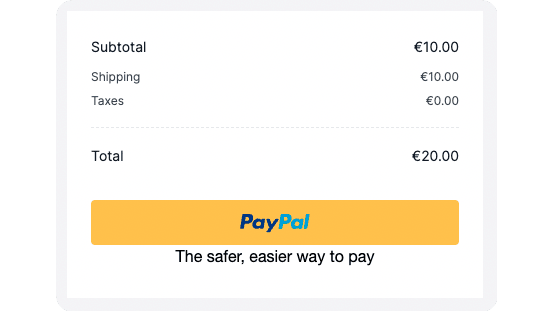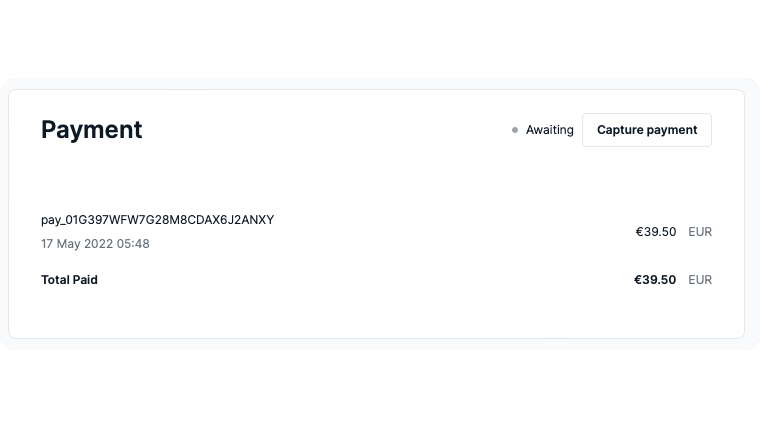PayPal
This document guides you through setting up PayPal as a payment processor in your Medusa backend, admin, and storefront using the PayPal plugin.
Overview
PayPal is a payment processor used by millions around the world. It allows customers to purchase orders from your website using their PayPal account rather than the need to enter their card details.
As a developer, you can use PayPal’s SDKs and APIs to integrate PayPal as a payment method into your ecommerce store. You can test out the payment method in sandbox mode before going live with it as a payment method.
Using the medusa-payment-paypal plugin, this guide shows you how to set up your Medusa backend with PayPal as a payment processor.
Prerequisites
Before you proceed with this guide, make sure you create a PayPal account. You also need a PayPal Developer account and retrieve the Client ID and Client Secret. You can learn more about how to do that in PayPal’s documentation.
In addition, you need to configure a webhook listener on your PayPal Developer Dashboard and obtain the webhook ID. This is necessary for Webhooks to work.
Webhooks are used in scenarios where the customer might leave the page during the authorization and before the checkout flow is fully complete. It will then create the order or swap after the payment is authorized if they weren’t created.
The API Route for PayPal webhook integration with your Medusa backend should be set to {BACKEND_URL}/paypal/hooks. Make sure to replace {BACKEND_URL} with the URL to your backend.
Additionally, you need a Medusa backend installed and set up. If not, you can follow the quickstart guide to get started.
You also need Medusa Admin installed to enable PayPal as a payment processor. You can alternatively use the REST APIs.
Medusa Backend
Install the PayPal Plugin
In the root of your Medusa backend, run the following command to install the PayPal plugin:
Configure the PayPal Plugin
Next, you need to add configurations for your PayPal plugin.
In the .env file add the following new environment variables:
Where <CLIENT_ID>, <CLIENT_SECRET>, and <WEBHOOK_ID> are the keys you retrieved from the PayPal Developer dashboard as explained in the Prerequisites section.
Notice that during development it’s highly recommended to set PAYPAL_SANDBOX to true and ensure you have sandbox accounts set up in PayPal.
Then, in medusa-config.js, add the PayPal plugin to the plugins array with the configurations necessary:
That’s all you need to install PayPal on your Medusa backend!
The PayPal plugin also accepts the following optional configurations:
capture: : a boolean value that indicates whether payment should be captured manually or automatically. By default, it will be false, leading admins to capture the payment manually.
Admin Setup
This section will guide you through adding PayPal as a payment processor in a region using your Medusa Admin dashboard.
This step is required for you to be able to use PayPal as a payment processor in your storefront.
Admin Prerequisites
If you don’t have a Medusa Admin installed, make sure to follow along with the guide on how to install it before continuing with this section.
Add PayPal to Regions
You can refer to this documentation in the user guide to learn how to add a payment processor like PayPal to a region.
Storefront Setup
This section will take you through the steps to add PayPal as a payment method on the storefront. It includes the steps necessary when using one of Medusa’s official storefronts as well as your own custom React-based storefront.
Storefront Prerequisites
All storefronts require that you obtain your PayPal Client ID. You can retrieve it from your PayPal developer dashboard.
Process Overview
Aside from the Next.js Starter Template, you need to add the implementation with PayPal manually.
It is recommended to read through the Frontend Checkout Flow first to fully understand how payment is implemented on the storefront.
Although the next sections have different implementations to add PayPal into your storefront, they essentially follow the same process:
- Show PayPal’s button if the PayPal processor is available for the current cart.
- When the button is clicked, open PayPal’s payment portal and wait for the customer to authorize the payment.
- If the payment is authorized successfully, set PayPal’s Payment Session as the session used to perform the payment for the current cart, then update the Payment Session on the backend with the data received from PayPal’s payment portal. This data is essential to the backend to verify the authorization and perform additional payment processing later such as capturing payment.
- Complete the cart to create the order.
In Medusa, by default, payments are authorized during checkout, but the payment is not captured right away. The payment should be manually captured from the Medusa Admin.
Add to Next.js Starter Template
Medusa has a Next.js Starter Template that you can easily use with your Medusa backend. If you don’t have the storefront installed, you can follow this quickstart guide.
In your .env.local file (or the file you’re using for your environment variables), add the following variable:
Make sure to replace <YOUR_CLIENT_ID> with your PayPal Client ID.
Now, if you run your Medusa backend and your storefront, on checkout you’ll be able to use PayPal].

You can test out the payment with PayPal using your sandbox account.
Add to Custom Storefront
This section guides you to add PayPal into a React-based framework. The instructions are general instructions that you can use in your storefront.
In your storefront, you need to install the PayPal React components library and the Medusa JS Client library:
Then, add the Client ID as an environment variable based on the framework you’re using.
Next, create the file that will hold the PayPal component with the following content:
import {
PayPalButtons,
PayPalScriptProcessor,
} from "@paypal/react-paypal-js"
import { useEffect, useState } from "react"
import Medusa from "@medusajs/medusa-js"
function Paypal() {
const client = new Medusa()
const [errorMessage, setErrorMessage] = useState(undefined)
const [processing, setProcessing] = useState(false)
const cart = "..." // TODO retrieve the cart here
const handlePayment = (data, actions) => {
actions.order.authorize().then(async (authorization) => {
if (authorization.status !== "COMPLETED") {
setErrorMessage(
`An error occurred, status: ${authorization.status}`
)
setProcessing(false)
return
}
const response = await client
.carts
.setPaymentSession(cart.id, {
"provider_id": "paypal",
})
if (!response.cart) {
setProcessing(false)
return
}
await client
.carts
.updatePaymentSession(cart.id, "paypal", {
data: {
data: {
...authorization,
},
},
})
const { data } = await client.carts.complete(cart.id)
if (!data || data.object !== "order") {
setProcessing(false)
return
}
// order successful
alert("success")
})
}
return (
<div style={{ marginTop: "10px", marginLeft: "10px" }}>
{cart !== undefined && (
<PayPalScriptProcessor options={{
"client-id": "<CLIENT_ID>",
"currency": "EUR",
"intent": "authorize",
}}>
{errorMessage && (
<span className="text-rose-500 mt-4">
{errorMessage}
</span>
)}
<PayPalButtons
style={{ layout: "horizontal" }}
createOrder={async () =>
cart.payment_session.data.id as string}
onApprove={handlePayment}
disabled={processing}
/>
</PayPalScriptProcessor>
)}
</div>
)
}
export default Paypal
Here’s briefly what this code snippet does:
- At the beginning of the component, the Medusa client is initialized using the JS Client you installed.
- You also need to retrieve the cart. Ideally, the cart should be managed through a context. So, every time the cart has been updated the cart should be updated in the context to be accessed from all components.
- This component renders a PayPal button to initialize the payment using PayPal. You use the components from the PayPal React components library to render the button and you pass the
PayPalScriptProcessorcomponent the Client ID. Make sure to replace<CLIENT_ID>with the environment variable you added. The PayPal button usesidprovided from backend to inject total amount with currency. - When the button is clicked, the
handlePaymentfunction is executed. In this method, you initialize the payment authorization usingactions.order.authorize(). It takes the customer to another page to log in with PayPal and authorize the payment. - After the payment is authorized successfully on PayPal’s portal, the fulfillment function passed to
actions.order.authorize().thenwill be executed. - In the fulfillment function, you first ensure that the payment session for the PayPal payment processor is set as the selected Payment Session in the cart. Then, you send a request to the backend to update the payment session data with the authorization data received from PayPal.
- You then complete the cart and place the order. If that is done successfully, you just show a success alert. You can change this based on the behavior you want in your storefront.
You can then import this component where you want to show it in your storefront.
If you run the Medusa backend and the storefront backend, you should see the PayPal button on checkout.

Capture Payments
After the customer places an order, you can see the order on the admin panel. In the payment information under the “Payment” section, you should see a “Capture” button.

Clicking this button lets you capture the payment for an order. You can also refund payments if an order has captured payments.
Refunding or Capturing payments is reflected in your PayPal dashboard as well.
See Also
- Check out more plugins you can add to your store.